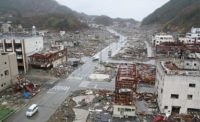For the U.S., the clear danger from a tsunami lies just offshore in the Pacific seabed where the Cascadia Subduction Zone shows up as a fault stretching about 800 miles, from Vancouver Island to Punta Gorda, Calif.

Seismologists say it has the potential to do almost exactly what happened on March 11 off Japan’s northeastern coast: generate a giant earthquake and tsunami that would hit the coast in minutes.
Subduction-zone faults can abruptly shift seabed elevation, which spawns a tsunami. Long faults that break all at once—such as the 1,600-kilometer-long fault that caused the Indonesian tsunami in December 2004—pose the greatest risk.
“From northern California down, the faults are strike slip. The subduction zones are far enough away that the tsunami risk is a two- to three-foot wave,” says Stephanie A. King, director of risk analysis at Weidlinger Associates Inc. But to the north, engineered protections, such as vertical escape structures, are being considered. She says awareness is growing.
“The risk of tsunami on the East Coast of that magnitude is relatively low,” King adds, “but the risk of flooding from other reasons, such as hurricane storm surge, could be higher than we think.”
As events in Japan unfold, however, she says it has become clear that protecting facilities from one hazard at a time is not good enough. For resilience, facilities such as nuclear plants on the East Coast and the Gulf of Mexico need physical protections as well as operational response plans against the risk not only of storm surge, but also fire, operational error and intentional damage in combination.
On the eastern side of the country, tsunami risk from seismic or volcanic activity is judged lower. Louis A. Gritzo, vice president of research at FM Global, a business property insurance company in Johnston, R.I., says that is because the data on frequency and probability of potential tsunami-producing events in the eastern region does not support action; however, the risk does exist. The company commissioned a study of tsunami risk to the East Coast in 2005. “We did not come up with conclusive results that would drive us to take actions,” Gritzo says.
A 2008 study by the Aon Benfield UCL Hazard Research Centre at University College in London and a paper by Matt Hornback, a researcher at the University of Texas at Austin’s Institute for Geophysics, have found evidence of potential tsunami-producing undersea landslides in the Caribbean. The studies raise concerns about energy buildup in the subduction zone that follows the curve of the lesser Antilles, from the Puerto Rico Trench to the U.S. Virgin Islands and down to Trinidad. They warn that the risk of a great earthquake may be significantly underappreciated.



Post a comment to this article
Report Abusive Comment